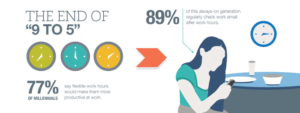Today’s guest blogger is Alana Davis of MAU Workforce Solutions, specializing in staffing, recruiting and outsourcing solutions for employers across the US and around the world through global recruiting partners.
Google Millennials in the Workplace or any other search involving millennials and employment, and there will be no shortage of articles, studies, and other content offering insight and data on how this generation operates in today’s workforce. Fortunately, the older Millennial group has now been in the workforce for five plus years.
Whether you have figured out the magic formula to working with Gen Y in your organization, or are still trying to grasp social media (what’s Snapchat??) and understand how emojis work, as more Millennials join the workforce in the coming years, there are a few key items to consider.
Here are the final four tips to make part of your recruiting and retention strategy.
1. “Meet” them where they are. Since the birth of Facebook, Millennials have been glued to social media. And now, with Instagram, Snapchat, and even Facebook Live, social media is where we spend our time! As an employer, having a presence on social media is crucial. Job seekers not only look to a company’s social media presence to gauge a company’s culture, but they may also use it as a form of communication, such as Facebook posts and messaging, or making comments to an Instagram picture. And you want to be right there, ready to engage! A company may even want to dedicate someone that responds to these forms of communication so not to lose the opportunity to engage potential quality employees!
2. Make the initial application simple. This cannot be emphasized enough! In a recent post, we discussed how our attention span has significantly decreased and is now shorter than that of a goldfish. And this is true for more than just the Millennial generation. As consumers, we have accessibility to quick fixes, solutions, and service. The job seeker wants the same thing, especially when initially applying or showing interest in a position. Try to make the initial application simple by having a short form for the job seeker to fill out with maybe an option to attach his/her resume. Since we know most people apply on mobile devices, the simpler the process is, the more applicants’ attention you’ll keep to finish the initial app.
3. Culture, Culture, Culture! When Millennials are looking for a new opportunity, one of their top priorities is making sure that they will fit in with the company culture. They want to know that they will be able to believe in what they do. This is key both in the recruiting and retention strategy. Use the job description as a way to give snippets of your culture by including the organization’s mission and values. Also, use social media to share the company’s culture with both prospective and current employees. Post pictures of company and community events, office gatherings, or holiday celebrations. This will help the job seeker understand what the work environment might be like, while also reinforcing the culture to current employees.
4. Embrace flexibility. In a recent article from the Charleston Regional Business Journal, Peggy Frazier, global talent acquisition manager of Blackbaud said she is working to recruit  millennials who want more balance between work and their life outside of it. Because of technology, remote work and working beyond the regular 9-5 hours is possible. More and more job seekers are looking for flexible work and as the job market tightens, employers that embrace the trend will benefit in the long run. Consider evaluating positions in your organization that could be done remotely or with flexible hours. For example, at MAU, many of our professional recruiters work remotely and/or part time, so they can be with their families more. Embracing this type of work not only has been successful from a business perspective but has improved the employee’s job satisfaction!
millennials who want more balance between work and their life outside of it. Because of technology, remote work and working beyond the regular 9-5 hours is possible. More and more job seekers are looking for flexible work and as the job market tightens, employers that embrace the trend will benefit in the long run. Consider evaluating positions in your organization that could be done remotely or with flexible hours. For example, at MAU, many of our professional recruiters work remotely and/or part time, so they can be with their families more. Embracing this type of work not only has been successful from a business perspective but has improved the employee’s job satisfaction!
Hopefully you’re getting a handle on this multi-generational workforce we are all navigating in today’s world. As we continue on this journey, and work to continuously improve our recruiting and retention strategies, consider these final four tips.














